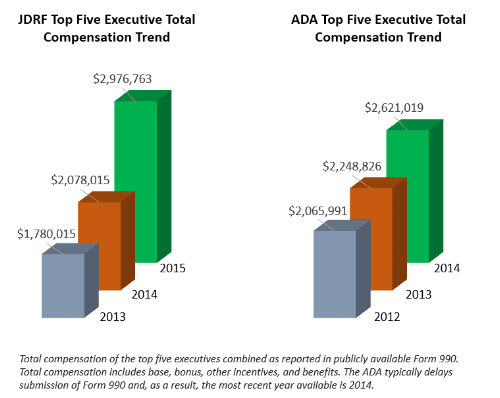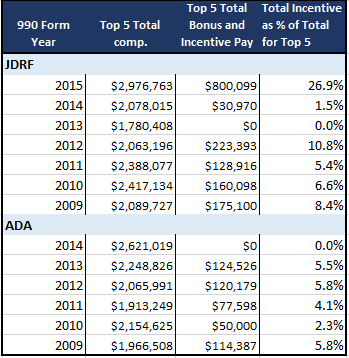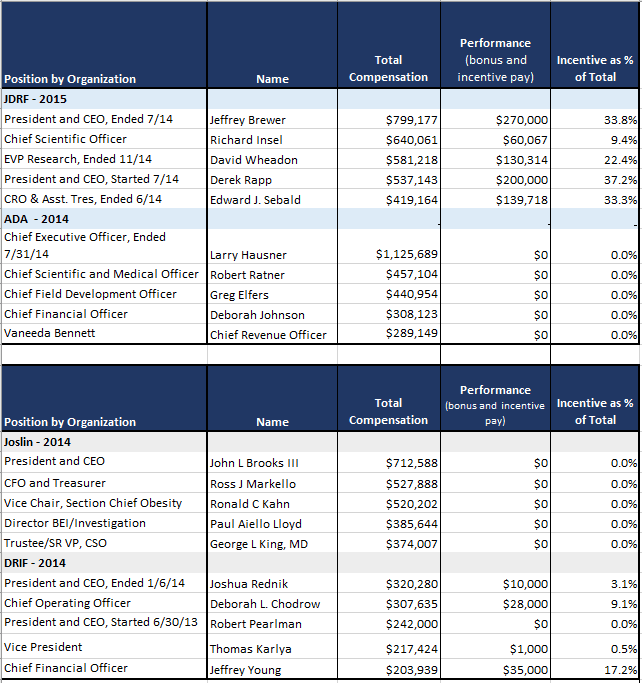
This is the fifth annual review of executive compensation for the top diabetes non-profits. The review will focus on the ADA and JDRF, the largest diabetes fundraising organizations, but also includes data in the appendix for Joslin and the DRI, two other notable diabetes organizations we periodically cover. All data is sourced from the publicly available Form 990, an annual submission mandated by the U.S. federal requirement for all nonprofit organizations.
One main finding from this review is that executive compensation has reached its highest level for both the ADA and JDRF, going back to 2009 when the JDCA began tracking this information. The average pay to each of the JDRF's top five executives was $595,352, up from $415,603 the year before. The average pay to each of the ADA's top five executives was $524,204, up from $449,765 the year before. See Appendix A.
The pay level of these executives places them in the top 1% of all earners in the United States. We have no inherent issue with competitive compensation, but we also strongly believe that in return for this pay level these individuals should be held to a very high standard of accountability and performance as measured by objective results toward finding a cure. The JDCA would like to see material progress toward a practical cure actively built into the compensation structure and a level of transparency in disclosure of compensation practices similar to the type of information for-profit entities must submit in proxy statements.
Furthermore, the increase in compensation of the past several years does not appear to be a result of a performance breakthrough such as a research result that yielded a clear path to a cure. The JDCA reached out to both organizations and asked them to provide rationale for the pay increase. The ADA declined to respond, while the JDRF provided an official reply that indicated management transition payments, such as severance and sign-on bonuses, as the primary driver. (Three executives left the organization and one joined during fiscal 2015). See Appendix B for the full official reply from the JDRF.
ADDITIONAL HIGHLIGHTS
- Bonus and incentive pay for the JDRF reached 27% of total compensation during 2015, the highest level by far since we have been tracking the data. This appears tied to severance and sign-on bonuses. See Appendix A.
- Bonus and incentive pay for the ADA was 0% in 2014, indicating that none of the compensation was tied directly to performance.
- The Chief Executive Officer of the ADA received $1,125,689 in compensation making him, by far, one of the most highly paid people working in diabetes. None of this pay was tied to performance metrics. See Appendix C.
- JDRF's outgoing CEO, Jeffrey Brewer, topped the compensation list during 2015 at $799,000. Our readers will recall that for most of his tenure Brewer received only $1 per year.
- Both Joslin and DRIF only have fiscal 2014 data available. Joslin executives earned an average of $504,066 and the DRIF executives earned an average of $258,256. None of the Joslin compensation was tied to performance while 6% of DRIF's total compensation was tied to bonus and incentives. See Appendix C.
APPENDIX A:

APPENDIX B: JDRF STATEMENT STATEMENT REGARDING COMPENSATION, AUGUST 19, 2016
"JDRF has adopted a compensation policy for its executives that has been vetted by nonprofit compensation consultants and approved by a committee of independent board of directors. This policy reflects best practice for the sector and is consistent with other non-profit charities of similar size. The FY15 figures appear higher than normal due to non-recurring events caused by management transitions."
APPENDIX C: 2015/14 COMPENSATION BY POSITION

